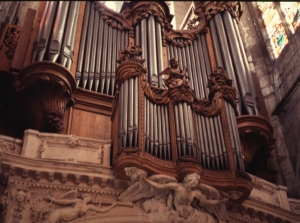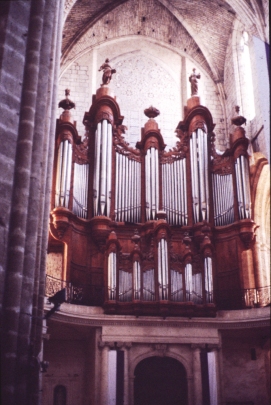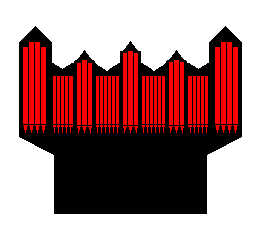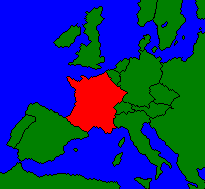Appearance
The case of the typical French Classical organ is similar in some ways to that
of other northern European organs of the time. The organ will usually be
found in a rear gallery, and you can expect to see two cases on these
instruments:
- The main case will be at some small distance from the front of the
gallery, with the keyboards built into the base. In many cases,
particularly in organs built in the early seventeenth century, the
base of the main case will be narrower than the main part, which will
extend beyond the sides of the base.
- A second, smaller case will be mounted on the gallery rail, at your
back when you are seated at the keydesk.
This second case was often designed as a miniature of the main case,
but without the narrow base found on the main organ.
 The photograph to the right is of the organ in the Church of St. Gervais in
Paris.
The instrument dates from the late seventeenth century, and the viewpoint from
which this photograph was made serves to illustrate the placement of the two
primary parts of the case.
The smaller case is not simply mounted on the front of the gallery rail - - it
actually forms the central section of it.
Although it is difficult to see in the photograph, you should also note that
the main case has an overhang at the impost level, giving it
the "tulip"
shape seen in seventeenth-century organs from the lowlands.
The photograph to the right is of the organ in the Church of St. Gervais in
Paris.
The instrument dates from the late seventeenth century, and the viewpoint from
which this photograph was made serves to illustrate the placement of the two
primary parts of the case.
The smaller case is not simply mounted on the front of the gallery rail - - it
actually forms the central section of it.
Although it is difficult to see in the photograph, you should also note that
the main case has an overhang at the impost level, giving it
the "tulip"
shape seen in seventeenth-century organs from the lowlands.
Looking at the photograph above, you might think that the organ had only two
divisions -- after all, there are only two cases, or boxes, visible. If you
thought
about it a little longer, and if you were familiar with earlier organs from
the
lowlands, you would think about the possibility of a small pedal division
located
behind the main case. Either way, you would expect to see a divided main case
if
there were other manual divisions present in the organ.
The French Classical organ case was not divided, though,
either in its internal structure (so that each division was in it
own separate "box")
or in its façade (so that the appearance of the pipe display
was evidence of the internal layout).
In a French case of the seventeenth or eighteenth centuries,
the pipes in the façade all stood at impost level, arranged in
- single-story flats
- and rounded towers,
- with the taller towers at the ends of the façade.
The placement of all pipes in the main chest on one level presented something
of a
problem in large instruments, because there were only two ways to build a
large case
and still maintain the basic design principle. In a large organ,
- the case could be deeper (from front to back),
- or it could be wider (taking up more space from side to side).
A deeper case would not have projected the sound as well as a shallow one, so
the
usual solution in building the case of a large French Classical organ was to
make the
case wide and shallow.
 Extreme widths make the flats so wide that balance between flats and towers
seemed to be lost, so most very large French Classical organs extend the
concept of flats and towers in alternation to include five towers.
The photograph to the left is of the 1773 organ built by J. E. Isnard at the
basilica of Ste.
Marie Madeleine in St. Maximin-en-Var in South France. Both the main case and the
positif have
façades that show all pipe feet standing on the same level, with five rounded
towers
separated by single-story flats. Even with the added width, the extension of the
main case at
the impost level means the narrower base that the French inherited from their
lowlands
predecessors is retained.
Extreme widths make the flats so wide that balance between flats and towers
seemed to be lost, so most very large French Classical organs extend the
concept of flats and towers in alternation to include five towers.
The photograph to the left is of the 1773 organ built by J. E. Isnard at the
basilica of Ste.
Marie Madeleine in St. Maximin-en-Var in South France. Both the main case and the
positif have
façades that show all pipe feet standing on the same level, with five rounded
towers
separated by single-story flats. Even with the added width, the extension of the
main case at
the impost level means the narrower base that the French inherited from their
lowlands
predecessors is retained.
 Look at the diagram to the right - - a visual mnemonic that might help you recognize
the
characteristics of French cases in the future.
The outline of such cases resembles the skyline of a chateau, with the large
towers at the extremes looking like towers along a castle wall, and the other
towers looking like the silhouettes of buildings within a castle keep.
In fact, if you move the mouse pointer over the diagram, you will see just how
close the resemblance can be between the contours of a large French Classical
organ and that of a French chateau.
Look at the diagram to the right - - a visual mnemonic that might help you recognize
the
characteristics of French cases in the future.
The outline of such cases resembles the skyline of a chateau, with the large
towers at the extremes looking like towers along a castle wall, and the other
towers looking like the silhouettes of buildings within a castle keep.
In fact, if you move the mouse pointer over the diagram, you will see just how
close the resemblance can be between the contours of a large French Classical
organ and that of a French chateau.
|


 The photograph to the right is of the organ in the Church of St. Gervais in
Paris.
The instrument dates from the late seventeenth century, and the viewpoint from
which this photograph was made serves to illustrate the placement of the two
primary parts of the case.
The smaller case is not simply mounted on the front of the gallery rail - - it
actually forms the central section of it.
Although it is difficult to see in the photograph, you should also note that
the main case has an overhang at the
The photograph to the right is of the organ in the Church of St. Gervais in
Paris.
The instrument dates from the late seventeenth century, and the viewpoint from
which this photograph was made serves to illustrate the placement of the two
primary parts of the case.
The smaller case is not simply mounted on the front of the gallery rail - - it
actually forms the central section of it.
Although it is difficult to see in the photograph, you should also note that
the main case has an overhang at the  Extreme widths make the flats so wide that balance between flats and towers
seemed to be lost, so most very large French Classical organs extend the
concept of flats and towers in alternation to include five towers.
The photograph to the left is of the 1773 organ built by J. E. Isnard at the
basilica of Ste.
Marie Madeleine in St. Maximin-en-Var in South France. Both the main case and the
positif have
façades that show all pipe feet standing on the same level, with five rounded
towers
separated by single-story flats. Even with the added width, the extension of the
main case at
the impost level means the narrower base that the French inherited from their
lowlands
predecessors is retained.
Extreme widths make the flats so wide that balance between flats and towers
seemed to be lost, so most very large French Classical organs extend the
concept of flats and towers in alternation to include five towers.
The photograph to the left is of the 1773 organ built by J. E. Isnard at the
basilica of Ste.
Marie Madeleine in St. Maximin-en-Var in South France. Both the main case and the
positif have
façades that show all pipe feet standing on the same level, with five rounded
towers
separated by single-story flats. Even with the added width, the extension of the
main case at
the impost level means the narrower base that the French inherited from their
lowlands
predecessors is retained.
